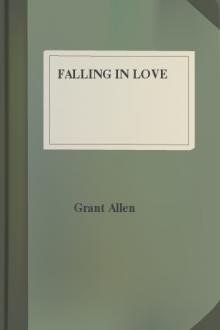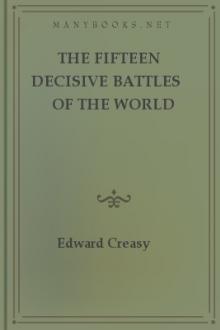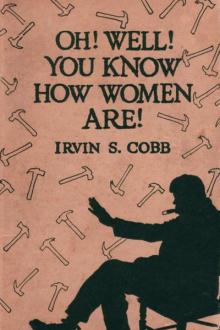Falling in Love by Grant Allen (different e readers .txt) 📕

- Author: Grant Allen
- Performer: -
Book online «Falling in Love by Grant Allen (different e readers .txt) 📕». Author Grant Allen
The big stone hut in which we found ourselves was, in fact, a buried cromlech, covered all over (until we opened it) by the earth of the barrow. Almost every cromlech, wherever found, was once, I believe, the central chamber of just such a long barrow: but in some instances wind and rain have beaten down and washed away the surrounding earth (and then we call it a 'Druidical monument'), while in others the mound still encloses its original deposit (and then we call it merely a prehistoric tumulus). As a matter of fact, even the Druids themselves are quite modern and common-place personages compared with the short, squat chieftains of the long barrows. For all the indications we found in the long barrow at Ogbury (as in many others we had opened elsewhere) led us at once to the strange conclusion that our new acquaintance, the skeleton, had once been a living cannibal king of the newer stone-age in Britain.
The only weapons or implements we could discover in the barrow were two neatly chipped flint arrowheads, and a very delicate ground greenstone hatchet, or tomahawk. These were the weapons of the dead chief, laid beside him in the stone chamber where we found his skeleton, for his future use in his underground existence. A piece or two of rude hand-made pottery, no doubt containing food and drink for the ghost, had also been placed close to his side: but they had mouldered away with time and damp, till it was quite impossible to recover more than a few broken and shapeless fragments. There was no trace of metal in any way: whereas if the tribesmen of our friend the skeleton had known at all the art of smelting, we may be sure some bronze axe or spearhead would have taken the place of the flint arrows and the greenstone tomahawk: for savages always bury a man's best property together with his corpse, while civilised men take care to preserve it with pious care in their own possession, and to fight over it strenuously in the court of probate.
The chief's own skeleton lay, or rather squatted, in the most undignified attitude, in the central chamber. His people when they put him there evidently considered that he was to sit at his ease, as he had been accustomed to do in his lifetime, in the ordinary savage squatting position, with his knees tucked up till they reached his chin, and his body resting entirely on the heels and haunches. The skeleton was entire: but just outside and above the stone vault we came upon a number of other bones, which told another and very different story. Some of them were the bones of the old prehistoric short-horned ox: others belonged to wild boars, red deer, and sundry similar animals, for the most part skulls and feet only, the relics of the savage funeral feast. It was clear that as soon as the builders of the barrow had erected the stone chamber of their dead chieftain, and placed within it his honoured remains, they had held a great banquet on the spot, and, after killing oxen and chasing red deer, had eaten all the eatable portions, and thrown the skulls, horns, and hoofs on top of the tomb, as offerings to the spirit of their departed master. But among these relics of the funeral baked meats there were some that specially attracted our attention—a number of broken human skulls, mingled indiscriminately with the horns of deer and the bones of oxen. It was impossible to look at them for a single moment, and not to recognise that we had here the veritable remains of a cannibal feast, a hundred centuries ago, on Ogbury hill-top.
Each skull was split or fractured, not clean cut, as with a sword or bullet, but hacked and hewn with some blunt implement, presumably either a club or a stone tomahawk. The skull of the great chief inside was entire and his skeleton unmutilated: but we could see at a glance that the remains we found huddled together on the top were those of slaves or prisoners of war, sacrificed beside the dead chieftain's tomb, and eaten with the other products of the chase by his surviving tribesmen. In an inner chamber behind the chieftain's own hut we came upon yet a stranger relic of primitive barbarism. Two complete human skeletons squatted there in the same curious attitude as their lord's, as if in attendance upon him in a neighbouring ante-chamber. They were the skeletons of women—so our professional bone-scanner immediately told us—and each of their skulls had been carefully cleft right down the middle by a single blow from a sharp stone hatchet. But they were not the victims intended for the pièce de résistance at the funeral banquet. They were clearly the two wives of the deceased chieftain, killed on his tomb by his son and successor, in order to accompany their lord and master in his new life underground as they had hitherto done in his rude wooden palace on the surface of the middle earth.
We covered up the reopened sepulchre of the old cannibal savage king (after abstracting for our local museum the arrowheads and tomahawk, as well as the skull of the very ancient Briton himself), and when our archæological society, ably led by the esteemed secretary, stood two years later on the desecrated tomb, the grass had grown again as green as ever, and not a sign remained of the sacrilegious act in which one of the party then assembled there had been a prime actor. Looking down from the summit of the long barrow on that bright summer morning, over the gay group of picnicking archæologists, it was a curious contrast to reinstate in fancy the scene at that first installation of the Ogbury monument. In my mind's eye I saw once more the howling band of naked, yellow-faced and yellow-limbed savages surge up the terraced slopes of Ogbury Down; I saw them bear aloft, with beating of breasts and loud gesticulations, the bent corpse of their dead chieftain; I saw the terrified and fainting wives haled along by thongs of raw oxhide, and the weeping prisoners driven passively like sheep to the slaughter; I saw the fearful orgy of massacre and rapine around the open tumulus, the wild priest shattering with his gleaming tomahawk the skulls of his victims, the fire of gorse and low brushwood prepared to roast them, the heads and feet flung carelessly on top of the yet uncovered stone chamber, the awful dance of blood-stained cannibals around the mangled remains of men and oxen, and finally the long task of heaping up above the stone hut of the dead king the earthen mound that was never again to be opened to the light of day till, ten thousand years later, we modern Britons invaded with our prying, sacrilegious mattock the sacred privacy of that cannibal ghost. All this passed like a vision before my mind's eye; but I didn't mention anything of it at that particular moment to my fellow-archæologists, because I saw they were all much more interested in the pigeon-pie and the funny story about an exalted personage and a distinguished actress with which the model secretary was just then duly entertaining them.
Five thousand years or so slowly wore away, from the date of the erection of the long barrow, and a new race had come to occupy the soil of England, and had driven away or reduced to slavery the short, squat, yellow-skinned cannibals of the earlier epoch. They were a pastoral and agricultural people, these new comers, acquainted with the use and abuse of bronze, and far more civilised in every way than their darker predecessors. No trace remains behind to tell us now by what fierce onslaught the Celtic invaders—for the bronze-age folk were presumably Celts—swept through the little Ogbury valley, and brained the men of the older race, while they made slaves of the younger women and serviceable children. Nothing now stands to tell us anything of the long years of Celtic domination, except the round barrow on the bare down, just as green and as grass-grown nowadays as its far earlier and more primitive neighbour.
We opened the Ogbury round barrow at the same time as the other, and found in it, as we expected, no bones or skeleton of any sort, broken or otherwise, but simply a large cinerary urn. The urn was formed of coarse hand-made earthenware, very brittle by long burial in the earth, but not by any means so old or porous as the fragments we had discovered in the long barrow. A pretty pattern ran round its edge—a pattern in the simplest and most primitive style of ornamentation; for it consisted merely of the print of the potter's thumb-nail, firmly pressed into the moist clay before baking. Beside the urn lay a second specimen of early pottery, one of those curious perforated jars which antiquaries call by the very question-begging name of incense-cups; and within it we discovered the most precious part of all our 'find,' a beautiful wedge-shaped bronze hatchet, and three thin gold beads. Having no consideration for the feelings of the ashes, we promptly appropriated both hatchet and beads, and took the urn and cup as a peace-offering to the lord of the manor for our desecration of a tomb (with his full consent) on the land of his fathers.
Why did these bronze-age people burn instead of burying their dead? Why did they anticipate the latest fashionable mode of disposal of corpses, and go in for cremation with such thorough conviction? They couldn't have been influenced by those rather unpleasant sanitary considerations which so profoundly agitated the mind of 'Graveyard Walker.' Sanitation was still in a very rudimentary state in the year five thousand B.C.; and the ingenious Celt, who is still given to 'waking' his neighbours, when they die of small-pox, with a sublime indifference to the chances of infection, must have had some other and more powerful reason for adopting the comparatively unnatural system of cremation in preference to that of simple burial. The change, I believe, was due to a further development of religious ideas on the part of the Celtic tribesmen above that of the primitive stone-age cannibals.
When men began to bury their dead, they did so in the firm belief in another life, which life was regarded as the exact counterpart of this present one. The unsophisticated savage, holding that in that equal sky his faithful dog would bear him company, naturally enough had the dog in question killed and buried with him, in order that it might follow him to the happy hunting-grounds. Clearly, you can't hunt without your arrows and your tomahawk; so the flint weapons and the trusty bow accompanied their owner in his new dwelling-place. The wooden haft, the deer-sinew bow-string, the perishable articles of food and drink have long since decayed within the damp tumulus: but the harder stone and earthenware articles have survived till now, to tell the story of that crude and simple early faith. Very crude and illogical indeed it was, however, for it is quite clear that the actual body of the dead man was thought of as persisting to live a sort of underground life within the barrow. A stone hut was constructed for its use; real weapons and implements were left by its side; and slaves and wives were ruthlessly massacred, as still in Ashantee, in order that their bodies might accompany the corpse of the buried master in his subterranean dwelling. In all this we have clear evidence of a very inconsistent, savage, materialistic belief, not indeed in the immortality of the soul, but in the continued underground life of the dead body.
With the progress of time, however,





Comments (0)